Socio-Ecological Regionalization of the Urban Sub-Basins in Mexico
Abstract
:1. Introduction
Regionalization Algorithms
2. Materials and Methods
2.1. Study Area
2.2. Selection of Variables
2.3. Normalization of Variables
2.4. Reduction of Variables
2.5. Regionalization and Validation of the Cluster Analysis
3. Results and Discussion
3.1. Identification of Similar Groups
3.1.1. Environmental Subsystem
3.1.2. Social Subsystem
3.1.3. Economic Subsystem
3.1.4. Institutional Subsystem
4. Conclusions
Acknowledgments
Author Contributions
Conflicts of Interest
Appendix A
| Database | Sustainability Subsystem | Spatial Resolution | Variables Selected |
|---|---|---|---|
| National Institute of Statistics and Geography (Instituto Nacional de Estadística y Geografía [INEGI]) [37] | Social | 1 km | 1 |
| National System of Municipal Information (Sistema Nacional de Información Municipal [SNIM]) [62] | Social, Economic | Municipal | 21, 16 |
| Average disability-adjusted life years (DALYs) due to intestinal disease (DALYs) and mean natural water availability [63] | Social | 1 km | 2 |
| National Water Commission (Comisión Nacional del Agua (CONAGUA) [6] | Institutional | HAR * | 1 |
| Mexican Business Information System (Sistema de Información Empresarial Mexicano [SIEM]) [64] | Institutional | Municipal | 1 |
| National Association of Universities and Higher Education Institutions in Mexico (Asociación Nacional de Universidades e Instituciones de Educación Superior en México [ANUIES]) [65] | Institutional | Municipal | 1 |
| Worldclim [45] | Environmental | 1 km | 20 |
| Secretariat of the Environment and Natural Resources, National System of Environmental Indicators (Secretaría de Medio Ambiente y Recursos Naturales, Sistema Nacional de Indicadores Ambientales [SNIA-SEMARNAT]) [66] | Environmental | State, HAR * | 6 |
| * Hydrological-Administrative Region | Total | 69 | |
Appendix B
| Subsystem | Source | ID | Variable | Units/km2 of Sub-Basin | Range of Values | Effect | Description | |
|---|---|---|---|---|---|---|---|---|
| Min | Max | |||||||
| Environmental | SNIA-SEMARNAT | E1 | Soil degradation | % | 4.3 | 73.2 | − | Soil degradation caused by humans |
| E2 | Wastewater treatment plant efficiency | % | 29.4 | 98.3 | + | Ratio between treatment capacity of treatment plant and actual volume of treated wastewater | ||
| E3 | Disinfected water supply | L/inhab/day | 0.0 | 235.3 | + | Volume of disinfected water supply | ||
| E4 | Biochemical Oxygen Demand (indicator of contamination) | % | 0.0 | 23.9 | − | Average annual BOD values range from 30 to 120 mg/L | ||
| E5 | Biochemical Oxygen Demand (indicator of high levels of contamination) | % | 0.0 | 51.9 | − | Average annual BOD values higher than 120 mg/L | ||
| E6 | Intensity of groundwater use | % | 1.3 | 133.9 | − | Ratio between extraction volume and natural recharge of aquifer | ||
| WORLDCLIM | E7 | Average annual minimum temperature (Tmin) | °C | 2.4 | 22.9 | + | Period average, 1950–2000 | |
| E8 | Average annual maximum temperature (Tmax) | °C | 18.4 | 36.0 | − | Period average, 1950–2000 | ||
| E9 | Temperature seasonality | % | 6.3 | 76.6 | − | Standard deviation of temperature | ||
| E10 | Isothermality | % | 33.2 | 81.2 | + | Ratio of mean diurnal range to annual range | ||
| E11 | Mean temperature of the coldest month | °C | 4.3 | 27.6 | + | Period average, 1950–2000 | ||
| E12 | Mean temperature of the warmest month | °C | 13.2 | 31.3 | − | Period average, 1950–2000 | ||
| E13 | Mean diurnal range in temperature | °C | 5.9 | 19.8 | − | Monthly average multiplied by the difference between monthly Tmax and Tmin | ||
| E14 | Annual range in temperature | °C | 11.4 | 38.6 | − | Difference between Tmax of warmest month and Tmin of coldest month | ||
| E15 | Tmin of the coldest month | °C | 0.0 | 20.5 | + | Period average, 1950–2000 | ||
| E16 | Tmax of the warmest month | °C | 21.0 | 39.9 | − | Period average, 1950–2000 | ||
| E17 | Mean temperature of the wettest quarter | °C | 9.2 | 31.3 | − | Average of three wettest months of the year | ||
| E18 | Mean temperature of the driest quarter | °C | 9.2 | 31.3 | − | Average of three driest months of the year | ||
| E19 | Average annual precipitation | mm | 52.2 | 3681.5 | + | Period average, 1950–2000 | ||
| E20 | Precipitation seasonality | % | 44.4 | 125.8 | + | Precipitation coefficient of variation | ||
| E21 | Precipitation level of the wettest quarter | mm | 39.4 | 1663.7 | + | Average of three wettest months of the year | ||
| E22 | Precipitation level of the driest quarter | mm | 0.9 | 394.2 | + | Average of three driest months of the year | ||
| E23 | Precipitation level of the wettest month | mm | 16.4 | 610.5 | + | Period average, 1950–2000 | ||
| E24 | Precipitation level of the driest month | mm | 0.0 | 118.6 | + | Period average, 1950–2000 | ||
| E25 | Precipitation level of the warmest quarter | mm | 14.8 | 1044.5 | + | Average of three warmest months of the year | ||
| E26 | Precipitation level of the coldest quarter | mm | 5.9 | 730.4 | + | Average of three coldest months of the year | ||
| Social | INEGI | S1 | Proportion of urban land use per sub-basin | % | 0.1 | 57.3 | − | Percentage of sub-basin occupied by urban areas (more than 2500 inhabitants) |
| SNIM | S2 | Population attending school | Inhabitant | 0.3 | 997.9 | + | Population older than 3 years attending school | |
| S3 | Education level of female population | Year | 3.3 | 10.8 | − | Average years of schooling of female population | ||
| S4 | Education level of male population | Year | 3.9 | 10.9 | + | Average years of schooling of male population | ||
| S5 | Overall education level | Year | 3.7 | 10.8 | + | Average years of schooling of population | ||
| S6 | Population density | Inhabitant | 0.3 | 3633.4 | − | Number of inhabitants per km2 | ||
| S7 | Human Development Index (HDI) | Range 0–1 | 0.3 | 0.8 | + | Human Development Index | ||
| S8 | Marginalization index | Range 0–100 | 7.4 | 60.9 | − | Marginalization index | ||
| S9 | Population that speaks an indigenous language | Inhabitant | 0.0 | 90.2 | + | Number of inhabitants (≥3 years) that speak an indigenous language | ||
| S10 | Male population that speaks an indigenous language | Inhabitant | 0.0 | 44.6 | + | Number of male inhabitants (≥3 years) that speak an indigenous language | ||
| S11 | Female population that speaks an indigenous language | Inhabitant | 0.0 | 45.7 | + | Number of female inhabitants (≥3 years) that speak an indigenous language | ||
| S12 | Density of inhabited houses | House | 0.3 | 972.0 | − | Total number of inhabited houses | ||
| S13 | Houses with running water | House | 0.3 | 923.0 | + | Number of inhabited houses with running water | ||
| S14 | Houses without running water | House | 0.0 | 34.2 | − | Number of inhabited houses without running water | ||
| S15 | Houses with drainage service | House | 0.1 | 937.4 | + | Total number of inhabited houses connected to the drainage network or a septic tank | ||
| S16 | Houses without drainage service | House | 0.0 | 32.2 | − | Total number of inhabited houses without drainage | ||
| S17 | Houses with water, drainage, and electricity | House | 0.1 | 906.1 | + | Number of inhabited houses with running water, drainage, and electricity | ||
| S18 | Houses with basic goods | House | 0.0 | 968.6 | + | Number of inhabited houses with television, radio, refrigerator, washer, automobile, phone, cell phone, computer, and internet | ||
| S19 | Houses without basic goods | House | 0.0 | 9.0 | − | Number of inhabited houses without television, radio, refrigerator, washer, automobile, phone, cell phone, computer, and internet | ||
| S20 | Houses with electricity | House | 0.3 | 944.6 | + | Number of inhabited houses with electricity | ||
| S21 | Houses without electricity | House | 0.0 | 3.3 | − | Number of inhabited houses without electricity | ||
| S22 | Houses with sanitary facilities | House | 0.3 | 939.7 | + | Number of inhabited houses with toilet or sanitary facilities | ||
| GOMEZ-ALBORES (2012) [63] | S23 | Average disability-adjusted life years (DALYs) due to intestinal disease | Rate/10,000 inhab | 0.1 | 77.4 | − | Life years lost due to intestinal diseases | |
| S24 | Average natural water availability | m3/year | 0.0 | 2,541,539.7 | + | Mean natural water availability per capita | ||
| Economic | SNIM | Ec1 | Overall economic participation rate | % | 31.8 | 63.3 | + | Ratio of working population to overall population with capacity to work (≥15 years) |
| Ec2 | Male economic participation rate | % | 45.4 | 82.8 | + | Ratio of male working population to overall population with capacity to work (≥15 years) | ||
| Ec3 | Female economic participation rate | % | 6.6 | 45.2 | + | Ratio of female working population to overall population with capacity to work (≥15 years) | ||
| Ec4 | Gross domestic product (GDP) | $ | 0.0 | 514,410.2 | + | Gross domestic product per capita at the municipal level | ||
| Ec5 | Overall economically inactive population | Inhabitant | 0.1 | 1248.1 | − | Population that is pensioned or retired, including students, homemakers, and those that have a permanent physical or mental impairment that prevents them from working (≥12 years) | ||
| Ec6 | Economically inactive male population | Inhabitant | 0.0 | 362.9 | − | Economically inactive male population | ||
| Ec7 | Economically inactive female population | Inhabitant | 0.1 | 885.2 | − | Economically inactive female population | ||
| Ec8 | Overall economically active population | Inhabitant | 0.1 | 1588.0 | + | Population with a job, or looked for a job in the reference week (≥12 years) | ||
| Ec9 | Economically active male population | Inhabitant | 0.1 | 983.1 | + | Economically active male population | ||
| Ec10 | Economically active female population | Inhabitant | 0.0 | 605.0 | + | Economically active female population | ||
| Ec11 | Overall economically active and with a job | Inhabitant | 0.3 | 1518.9 | + | Population that had a job in the reference week (≥12 years) | ||
| Ec12 | Economically active male population with a job | Inhabitant | 0.1 | 927.8 | + | Economically active male population with a job | ||
| Ec13 | Economically active female population with a job | Inhabitant | 0.0 | 582.4 | + | Economically active female population with a job | ||
| Ec14 | Overall economically active population without a job | Inhabitant | 0.0 | 77.9 | − | Number of inhabitants who did not work or hold a job but looked for work in the previous week (≥12 years) | ||
| Ec15 | Economically active male population without a job | Inhabitant | 0.0 | 55.3 | − | Male population economically active without a job | ||
| Ec16 | Economically active female population without a job | Inhabitant | 0.0 | 22.6 | − | Female population economically active without a job | ||
| Institutional | ANUIES | I1 | Higher education institutions | Institution | 0.0 | 0.2 | + | Number of higher education institutions registered in ANUIES |
| SIEM | I2 | Business density | Businesses | 0.0 | 32.9 | − | Number of businesses registered in the Mexican Business Information System | |
| CONAGUA | I3 | Total water management organizations | Committees | 2.0 | 18.0 | + | Number of councils, commissions, basin committees, and groundwater committees per HAR | |
References
- United Nations. United Nations Millennium Declaration; United Nations: New York, NY, USA, 2000. [Google Scholar]
- Global Water Partnership (GWP). A Handbook for Integrated Water Resources Management in Basins; Elanders: Mölnlycke, Sweden, 2009. [Google Scholar]
- Berkes, F.; Folke, C.; Colding, J. Linking Social and Ecological Systems: Management Practices and Social Mechanisms for Building Resilience; Cambridge University Press: Cambridge, UK, 2000. [Google Scholar]
- Scott, C.A.; Banister, J.M. The dilemma of water management “regionalization” in Mexico under centralized resource allocation. Water Resour. Dev. 2008, 24, 61–74. [Google Scholar] [CrossRef]
- Water, U. Status Report on the Application of Integrated Approaches to Water Resources Management; United Nations Environment Programme: Nairobi, Kenya, 2012. [Google Scholar]
- Comisión Nacional del Agua (CONAGUA). Atlas Digital del Agua en México. Available online: http://www.CONAGUA.gob.mx/atlas/ (accessed on 25 April 2015).
- Gobierno de la República. Ley de Aguas Nacionales; Diario Oficial de la Federación: México D.F., Mexico, 2013. [Google Scholar]
- Perevochtchikova, M.; Arellano-Monterrosas, J.L. Gestión de cuencas hidrográficas: Experiencias y desafíos en México y Rusia. Rev. Latinoam. Recur. Nat. 2008, 4, 313–325. [Google Scholar]
- Bennett, C.J. What is policy convergence and what causes it? Br. J. Political Sci. 1991, 21, 215–233. [Google Scholar] [CrossRef]
- Dolowitz, D.; Marsh, D. Who learns what from whom: A review of the policy transfer literature. Political Stud. 1996, 44, 343–357. [Google Scholar] [CrossRef]
- Ortega, R.R. Convergencia de política hacía la gestión integral de recursos hídricos en México. Rev. Mex. Análisis Político Adm. Pública 2015, 4, 67–88. [Google Scholar]
- Salazar Adams, A.; Pineda Pablos, N. Factores que afectan la demanda de agua para uso doméstico en México. Reg. Soc. 2010, 22, 3–16. [Google Scholar]
- Platt, R.H. Urban watershed management: Sustainability, one stream at a time. Environ. Sci. Policy Sustain. Dev. 2006, 48, 26–42. [Google Scholar] [CrossRef]
- Allende, C.T.; Mendoza, M.E.; López Granados, E.M.; Morales Manilla, L.M. Hydrogeographical Regionalisation: An Approach for Evaluating the Effects of Land Cover Change in Watersheds. A Case Study in the Cuitzeo Lake Watershed, Central Mexico. Water Resour. Manag. 2009, 23, 2587–2603. [Google Scholar] [CrossRef]
- Pineda-Martínez, L.F.; Carbajal, N.; Medina-Roldan, E. Regionalization and classification of bioclimatic zones in the central-northeastern region of México using principal component analysis (PCA). Atmósfera 2007, 20, 133–145. [Google Scholar]
- Laaha, G.; Blöschl, G. A comparison of low flow regionalisation methods—Catchment grouping. J. Hydrol. 2006, 323, 193–214. [Google Scholar] [CrossRef]
- Mertens, M.; Nestler, I.; Huwe, B. GIS-based regionalization of soil profiles with Classification and Regression Trees (CART). J. Plant Nutr. Soil Sci. 2002, 165, 39–43. [Google Scholar] [CrossRef]
- Zhang, Q.; Wu, F.; Wang, L.; Yuan, L.; Zhao, L. Application of PCA integrated with CA and GIS in eco-economic regionalization of Chinese Loess Plateau. Ecol. Econ. 2011, 70, 1051–1056. [Google Scholar] [CrossRef]
- Darand, M.; Daneshvar, M.M.R. Regionalization of Precipitation Regimes in Iran Using Principal Component Analysis and Hierarchical Clustering Analysis. Environ. Process. 2014, 1, 517–532. [Google Scholar] [CrossRef]
- Shamshirband, S.; Gocić, M.; Petković, D.; Javidnia, H.; Ab Hamid, S.H.; Mansor, Z.; Qasem, S.N. Clustering project management for drought regions determination: A case study in Serbia. Agric. For. Meteorol. 2015, 200, 57–65. [Google Scholar] [CrossRef]
- MacQueen, J. Some methods for classification and analysis of multivariate observations. In Proceedings of the 5-th Berkeley Symposium on Mathematical Statistics and Probability, Oakland, CA, USA, 21 June–18 July 1967; Volume 1, pp. 281–297.
- Velmurugan, T.; Santhanam, T. Computational Complexity between K-Means and K-Medoids Clustering Algorithms for Normal and Uniform Distributions of Data Points. J. Comput. Sci. 2010, 3, 363–368. [Google Scholar] [CrossRef]
- Di Giuseppe, E.; Jona Lasinio, G.; Esposito, S.; Pasqui, M. Functional clustering for Italian climate zones identification. Theor. Appl. Climatol. 2013, 114, 39–54. [Google Scholar] [CrossRef]
- Park, H.-S.; Jun, C.-H. A simple and fast algorithm for K-medoids clustering. Expert Syst. Appl. 2009, 36, 3336–3341. [Google Scholar] [CrossRef]
- Kaufman, L.; Rousseeuw, P.J. Partitioning around medoids (program pam). In Finding Groups in Data: An Introduction to Cluster Analysis; John Wiley & Sons, Inc.: Hoboken, NJ, USA, 1990; pp. 68–125. [Google Scholar]
- Ng, R.T.; Han, J. CLARANS: A method for clustering objects for spatial data mining. IEEE Trans. Knowl. Data Eng. 2002, 14, 1003–1016. [Google Scholar] [CrossRef]
- Baarsch, J.; Celebi, M.E. Investigation of internal validity measures for K-means clustering. In Proceedings of the International MultiConference of Engineers and Computer Scientists, Hong Kong, China, 12–16 March 2012; Volume 1, pp. 14–16.
- Ahmed, R.; Mahmood, K.; Kausar, A. Socio-Agricultural Correlation and Regionalization: A Case of the Districts of Pakistan. J. Basic Appl. Sci. 2014, 10, 7–19. [Google Scholar] [CrossRef]
- Monroy-Ortiz, R. Los sistemas urbanos de cuenca en México: Transitando a estrategias integrales de gestión hídrica. Econ. Soc. Territ. 2013, 13, 151–179. [Google Scholar] [CrossRef]
- Carabias, J.; Landa, R. Agua, Medio Ambiente y Sociedad. Hacia la Gestión Integral de los Recursos Hídricos en México; UNAM: México D.F., Mexico, 2005. [Google Scholar]
- García, E. Clasificación de Köppen, Modificado por García, E.; CONABIO: México D.F., Mexico, 1998. [Google Scholar]
- Ceballos, G.; Valenzuela, D.; Ceballos, G.; Martínez, L.; García, A.; Espinoza, E.; Bezaury, J.J.; Dirzo, R. Diversidad, Amenazas y Áreas Prioritarias para la Conservación de las Selvas Secas del Pacífico de México; Fondo de Cultura Económica, CONABIO and CONANP: México D.F., Mexico, 2010. [Google Scholar]
- Comisión Nacional del Agua (CONAGUA). Atlas del Agua en México 2012; Secretaría de Medio Ambiente y Recursos Naturales: México D.F., Mexico, 2012. [Google Scholar]
- Gobierno de la República. Programa Nacional Hídrico 2014–2018; Diario Oficial de la Federación: México D.F., Mexico, 2014. [Google Scholar]
- Fondo para la Comunicación y la Educación Ambiental (FCEA), Centro Mexicano de Derecho Ambiental (CEMDA), Presencia Mexicana Ciudadana Mexicana (P.M.C.M.). Agua en México: Lo que Todos y Todas Debemos Saber; Fondo Educación Ambiental: México D.F., Mexico, 2006. [Google Scholar]
- Instituto Nacional de Estadística y Geografía (INEGI). Referencias Geográficas y Extensión Territorial de México; INEGI: México D.F., Mexico, 2010. [Google Scholar]
- Instituto Nacional de Estadística y Geografía (INEGI). Censo de Población y Vivienda. 2010. Available online: http://www.inegi.org.mx/est/contenidos/proyectos/ccpv/cpv2010/Default.aspx (accessed on 13 August 2015).
- Nieto, A.T. Las economías de las zonas metropolitanas de México en los albores del siglo XXI. Estud. Demogr. Urbanos 2013, 28, 545–591. [Google Scholar]
- Hearne, R.R. Evolving water management institutions in Mexico. Water Resour. Res. 2004, 40, W12S04. [Google Scholar] [CrossRef]
- Parnreiter, C. Ciudad de México: El camino hacia una ciudad global. EURE Santiago 2002, 28, 89–119. [Google Scholar] [CrossRef]
- Instituto Nacional de Estadística y Geografía (INEGI). Economía, Cuadro Resumen. Available online: http://www3.inegi.org.mx/sistemas/temas/default.aspx?s =est&c=23824 (accessed on 15 October 2015).
- Gobierno de la República. Plan Nacional de Desarrollo 2013–2018; Diario Oficial de la Federación: México D.F., Mexico, 2013. [Google Scholar]
- Comisión Nacional del Agua (CONAGUA). Estadísticas del Agua en México; Secretaría de Medio Ambiente y Recursos Naturales: México D.F., Mexico, 2015. [Google Scholar]
- Comisión Nacional del Agua (CONAGUA). Estadísticas del Agua en México; Secretaría de Medio Ambiente y Recursos Naturales: México D.F., Mexico, 2013. [Google Scholar]
- Hijmans, R.J.; Cameron, S.E.; Parra, J.L.; Jones, P.G.; Jarvis, A. Very high resolution interpolated climate surfaces for global land areas. Int. J. Climatol. 2005, 25, 1965–1978. [Google Scholar] [CrossRef]
- Eastman, J.R. IDRISI Selva; Clark University: Worcester, MA, USA, 2012. [Google Scholar]
- Environmental Systems Research Institute (ESRI). ArcGIS Desktop: Release 10; ESRI: Redlands, CA, USA, 2011. [Google Scholar]
- Eastman, J.R. Guide to GIS and Image Processing; Clark University: Worcester, MA, USA, 2012. [Google Scholar]
- Landeta, J. Current validity of the Delphi method in social sciences. Technol. Forecast. Soc. Chang. 2006, 73, 467–482. [Google Scholar] [CrossRef]
- Tan, L.; Liu, H.; Ma, Y.; Wu, L.; Min, Q.; Gao, S.; Liu, J. Quantification of spatial difference of sustainability in the Taihang Mountain area of Hebei Province, China, with its information platform and GIS. J. Food Agric. Environ. 2011, 9, 740–747. [Google Scholar]
- Statgraphics Centurion V15.2; Statpoint Technologies: Warrenton, VA, USA, 2009.
- Kaiser, H.F. The application of electronic computers to factor analysis. Educ. Psychol. Meas. 1960, 20, 141–151. [Google Scholar] [CrossRef]
- Shlens, J. A Tutorial on Principal Component Analysis: Derivation, Discussion and Singular Value Decomposition. 2003. Available online: https://www.cs.princeton.edu/picasso/mats/PCA-Tutorial-Intuition_jp.pdf (accessed on 28 December 2016).
- Rousseeuw, P.J. Silhouettes: A graphical aid to the interpretation and validation of cluster analysis. J. Comput. Appl. Math. 1987, 20, 53–65. [Google Scholar] [CrossRef]
- Lletí, R.; Ortiz, M.C.; Sarabia, L.A.; Sánchez, M.S. Selecting variables for k-means cluster analysis by using a genetic algorithm that optimises the silhouettes. Anal. Chim. Acta 2004, 515, 87–100. [Google Scholar] [CrossRef]
- R Development Core Team. R: A Language and Environment for Statistical Computing; R Foundation for Statistical Computing: Vienna, Austria, 2009; Available online: https://www.r-project.org (accessed on 15 October 2015).
- Instituto Nacional de Estadística (INE). Atlas de la Cuenca Lerma-Chapala: Construyendo una Visión Conjunta; Cotler Avalos, H., Mazari Hiriart, M., de Anda Sánchez, J., Eds.; INE: México D.F., Mexico, 2006. [Google Scholar]
- Legorreta, J. El Agua y la Ciudad de México de Tenochtitlán a la Megalópolis del Siglo XXI; Universidad Autónoma Metropolitana: México D.F., Mexico, 2006. [Google Scholar]
- Consejo Nacional de Evaluación de la Política de Desarrollo Social (CONEVAL). Evolución de la Pobreza en México. Medición de la Pobreza. 2014. Available online: http://www.coneval.gob.mx/Medicion/MP/Paginas/Pobreza_2014.aspx (accessed on 14 October 2015).
- Villanueva-Diaz, J.; Stahle, D.W.; Luckman, B.H.; Cerano-Paredes, J.; Therrell, M.D.; Cleaveland, M.K.; Cornejo-Oviedo, E. Winter-spring precipitation reconstructions from tree rings for northeast Mexico. Clim. Chang. 2007, 83, 117–131. [Google Scholar] [CrossRef]
- Huang, B.; Fan, T.; Li, Y.; Wang, Y. Division scheme for environmental management regionalization in China. Environ. Manag. 2013, 52, 289–307. [Google Scholar] [CrossRef] [PubMed]
- Instituto Nacional para el Federalismo y el Desarrollo Municipal. Sistema Nacional de Información Municipal (SNIM). Available online: http://www.snim.rami.gob.mx/ (accessed on 14 October 2015).
- Gómez-Albores, M.A. Modelación Geomática de Medidas de Frecuencia y de Asociación, Aplicada a Enfermedades Vinculadas con el Agua. Ph.D. Thesis, Universidad Autónoma del Estado de México, Facultad de Ingeniería, Centro Interamericano de Recursos del Agua (CIRA), Toluca de Lerdo, Mexico, 2012. [Google Scholar]
- Secretaría de Economía. Sistema de Información Empresarial Mexicano. Available online: http://www.siem.gob.mx/siem/portal/consultas/ligas.asp?Tem=1 (accessed on 14 October 2015).
- Asociación Nacional de Universidades e Instituciones de Educación Superior en México (ANUIES). Información Estadística de Educación Superior. Available online: http://www.anuies.mx/informacion-y-servicios/informacion-estadistica-de-educacion-superior (accessed on 14 October 2015).
- Secretaría del Medio Ambiente y Recursos Naturales (SEMARNAT). Sistema Nacional de Indicadores Ambientales. Available online: http://apps1.semarnat.gob.mx/dgeia/indicadores14/conjuntob/00_conjunto/temas.html?De=SNIA (accessed on 14 October 2015).
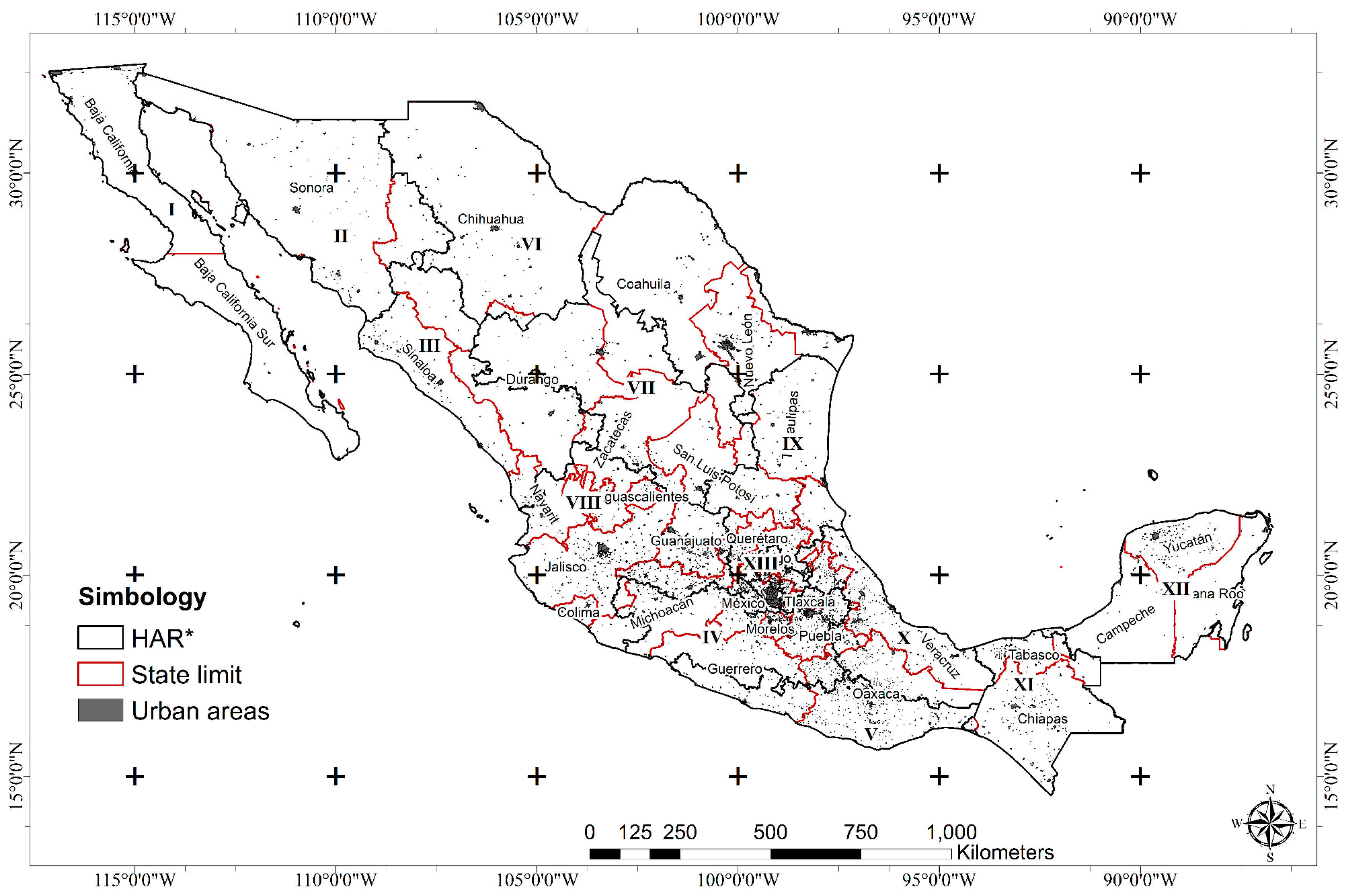
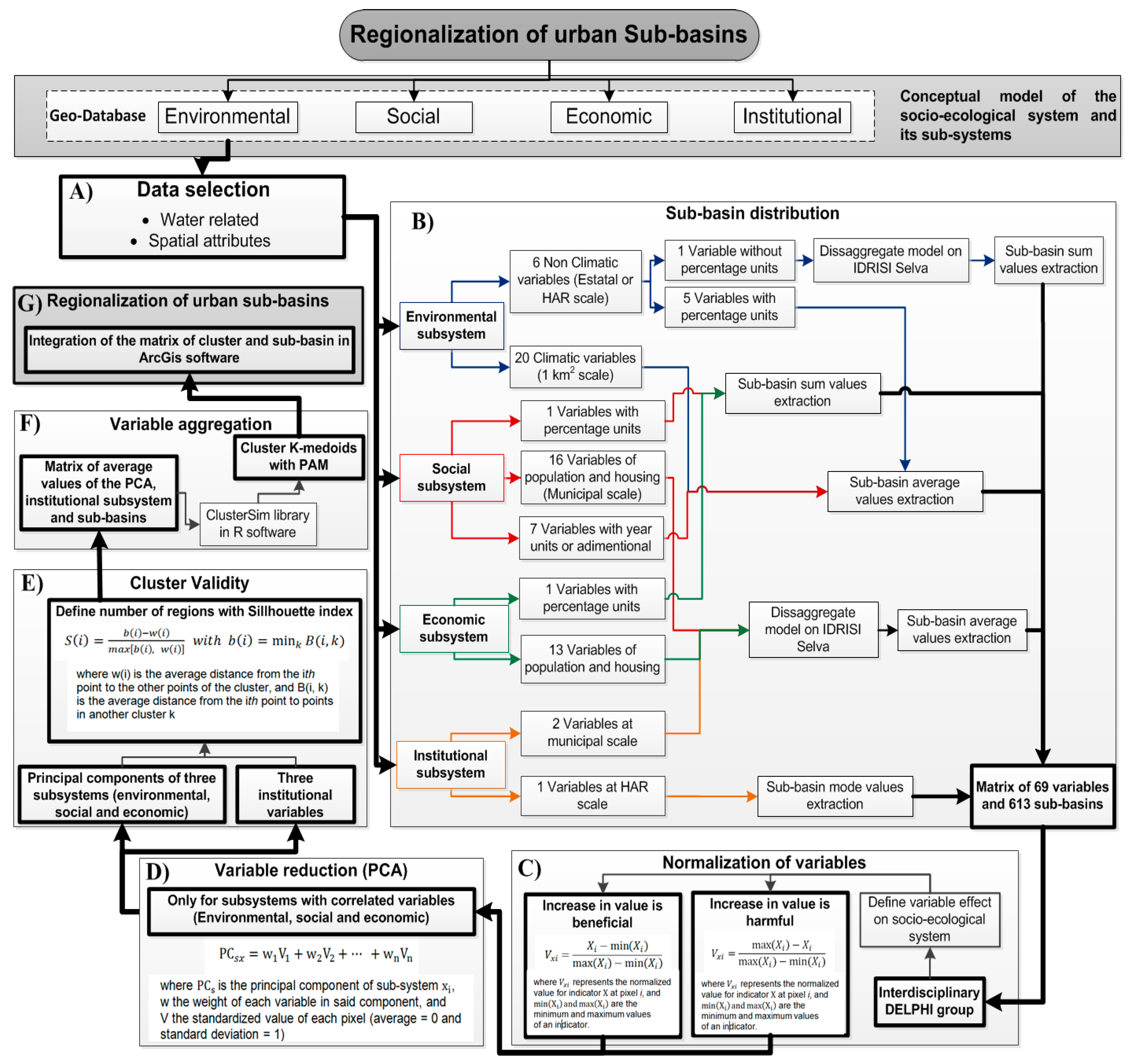
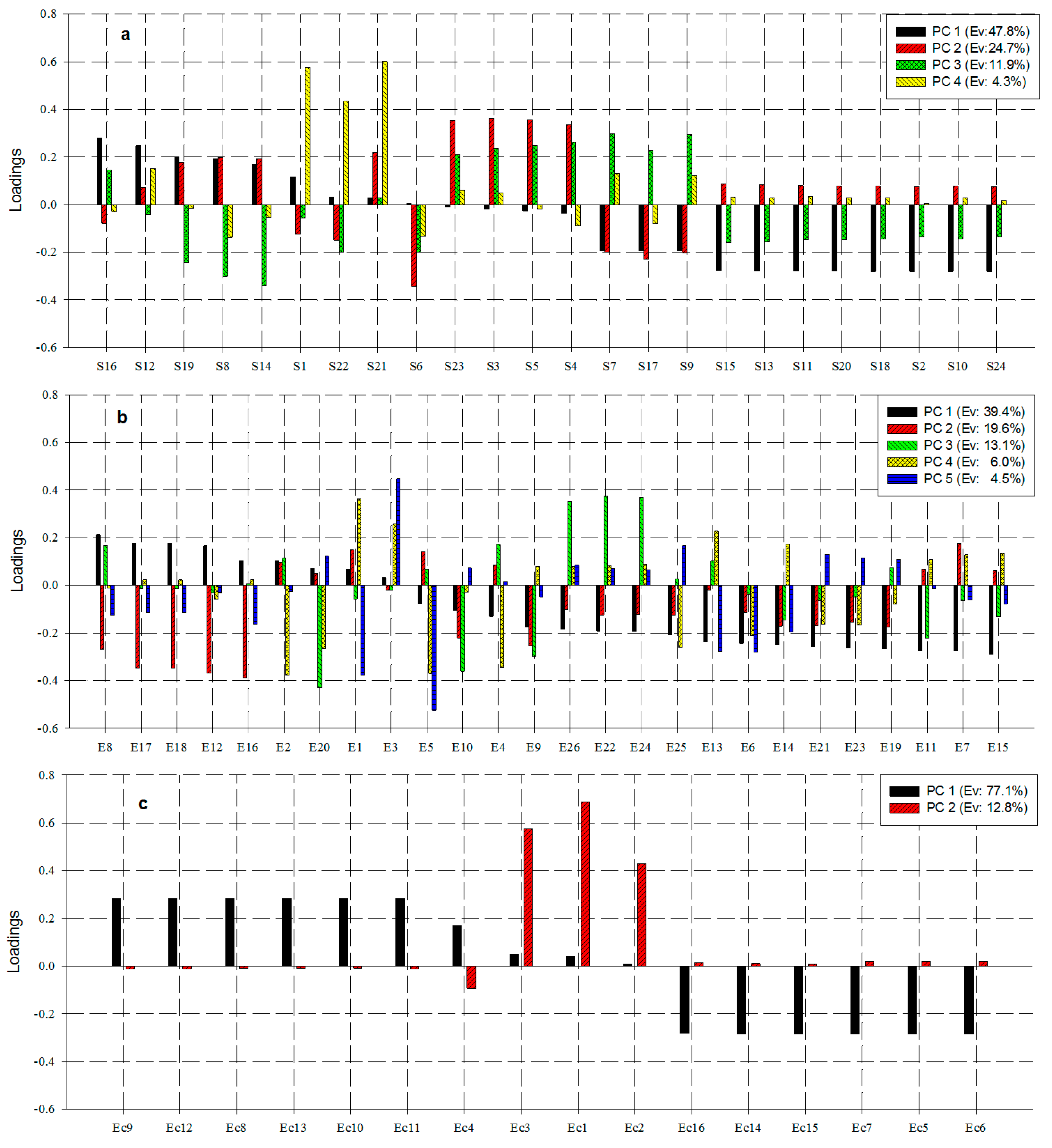
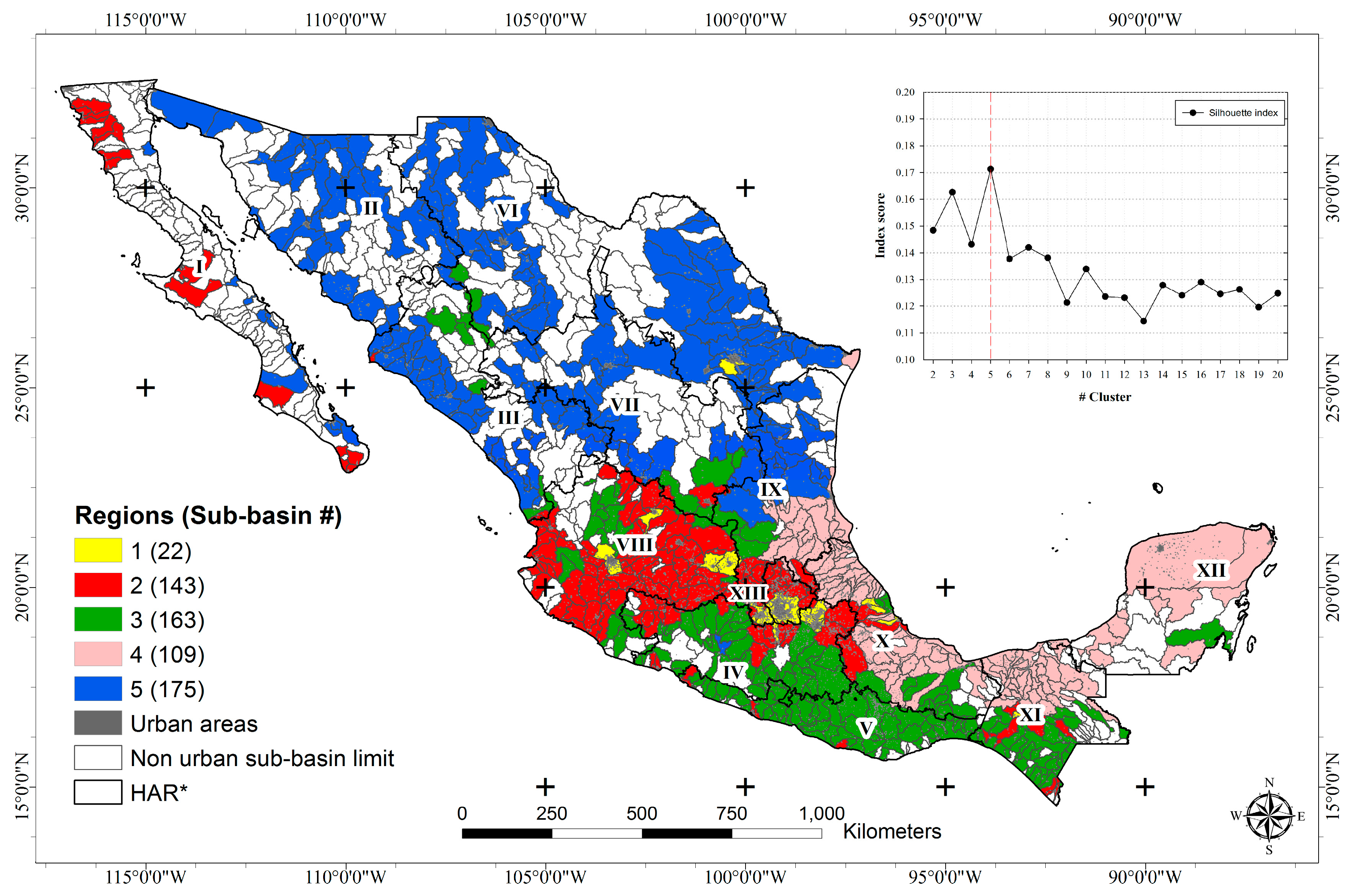

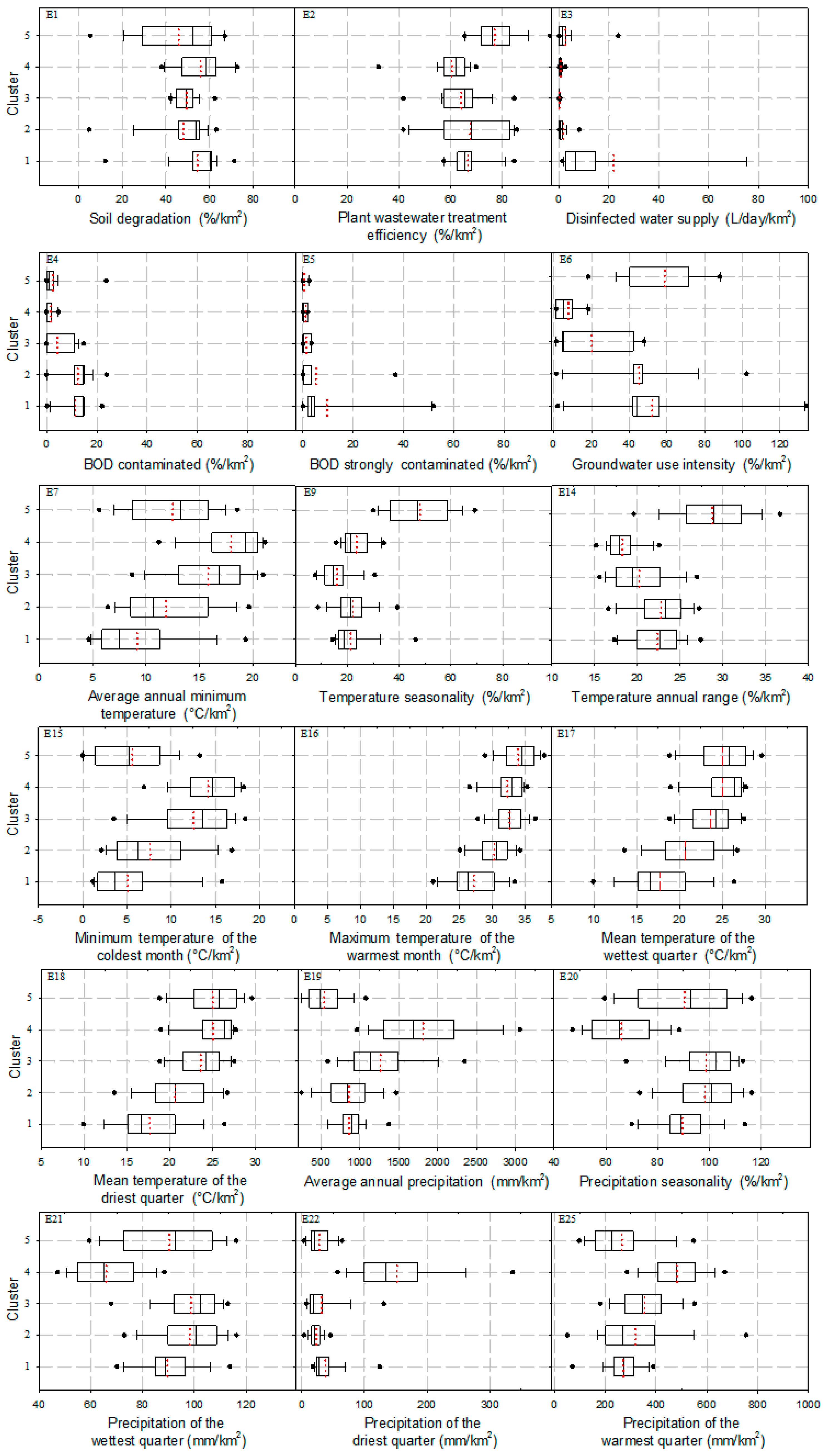



© 2017 by the authors; licensee MDPI, Basel, Switzerland. This article is an open access article distributed under the terms and conditions of the Creative Commons Attribution (CC-BY) license (http://creativecommons.org/licenses/by/4.0/).
Share and Cite
Cervantes-Jiménez, M.; Mastachi-Loza, C.A.; Díaz-Delgado, C.; Gómez-Albores, M.Á.; González-Sosa, E. Socio-Ecological Regionalization of the Urban Sub-Basins in Mexico. Water 2017, 9, 14. https://doi.org/10.3390/w9010014
Cervantes-Jiménez M, Mastachi-Loza CA, Díaz-Delgado C, Gómez-Albores MÁ, González-Sosa E. Socio-Ecological Regionalization of the Urban Sub-Basins in Mexico. Water. 2017; 9(1):14. https://doi.org/10.3390/w9010014
Chicago/Turabian StyleCervantes-Jiménez, Mónica, Carlos Alberto Mastachi-Loza, Carlos Díaz-Delgado, Miguel Ángel Gómez-Albores, and Enrique González-Sosa. 2017. "Socio-Ecological Regionalization of the Urban Sub-Basins in Mexico" Water 9, no. 1: 14. https://doi.org/10.3390/w9010014
APA StyleCervantes-Jiménez, M., Mastachi-Loza, C. A., Díaz-Delgado, C., Gómez-Albores, M. Á., & González-Sosa, E. (2017). Socio-Ecological Regionalization of the Urban Sub-Basins in Mexico. Water, 9(1), 14. https://doi.org/10.3390/w9010014





